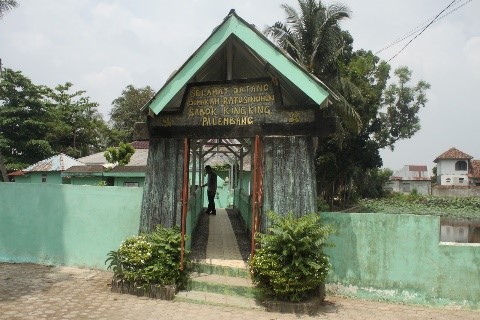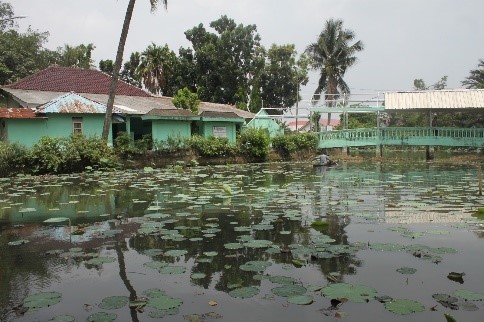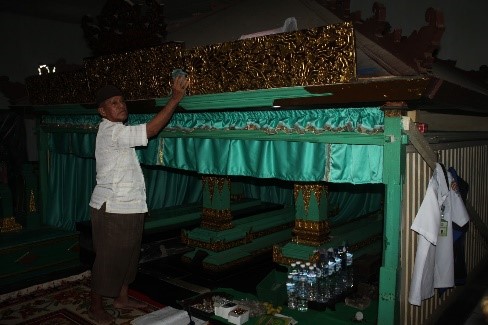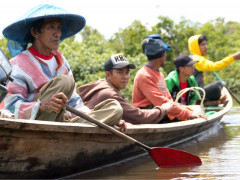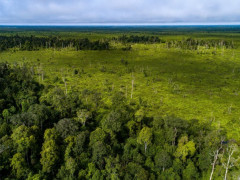2021: Flood and Drought. A Critical Study of South Kalimantan's Environmental Emergency
By Kisworo Dwi CahyonoSimbur Cahaya, the Eternal Local Wisdom
If you are interested in exploring the Simbur Cahaya Law, first you need to know more about its initiator and creator, Queen Sinuhun. She was the wife of Prince Sido Ing Kenayan, who ruled for six years from 1636 – 1642 AD. Queen Sinuhun is known as a role model because the law that she created contains local wisdom in terms of gender equality in social relations.
Kemas Ari Panji, an academic and historian from Raden Fatah State Islamic University in Palembang, said that Queen Sinuhun is a role model in many ways. The queen is not only known for her concern in managing the villages and the environment but is also known as a figure of women's emancipation. During her time in the 1630s, Queen Sinuhun showed that women were highly intellectual and equal to men. "Queen Sinuhun promoted gender equality and she is even more popular than her husband," said Ari Panji.
Because of this interesting figure and history, I visited the Sabok Kingking cemetery complex in Sei Buah, Ilir Timur II, Palembang City. This cemetery is about 500 years old and it is where the early kings of the Islamic kingdom of Palembang were buried. There are 41 tombs in an area of 100 x 100 meters. In this complex, there are also the tombs of Commander Kiai Kibagus Abdurrachman and Al Habib Al Arif Billah Umar bin Muhammad Al Idrus bin Sahab, who was the religious advisor of Prince Sido Ing Kenayan and Queen Sinuhun.
There I met a tomb keeper named Husni who told me a lot about the cemetery’s history. When it was discovered, this complex was still an ordinary graveyard without any buildings on it. Settlements were very rare, there were only jungle and swamps. "When it was first discovered, this cemetery was in the middle of a jungle and PT Pupuk Sriwidjaja Palembang (Pusri) was not established," he said.
The Simbur Cahaya Law is a blend of customary law and Islamic teachings. It is a written law based on Islamic law, which was first applied in this archipelago, especially in South Sumatra.
According to Saudi Berlian, a lecturer of Basic Cultural Studies at the University of South Sumatra, the Simbur Cahaya Law also teaches about harmony with the natural environment, socio-cultural environment, and religion. This book of law “Oendang-Oendang Simboer Tjahaja”, published by Typ. Industreeleel Mlj in Palembang in 1922, consists of 5 parts:
Chapter I: The Custom of Single and Married Men and Women (32 articles)
Chapter II: The Rules of Clan (29 articles)
Chapter III: The Rules of Village and Farming (32 articles)
Chapter IV: The Rules of Kaum (religious leaders) (19 articles)
Chapter V: The Custom of Law Enforcement (58 articles)
Taufik Wijaya, an environmental activist in Palembang, said that the Simbur Cahaya Law, especially Chapter III, explains a lot about the relationship between the environment and humans. It contains various rules on how to burn the land so as not to harm others, how to raise livestock, prohibition of catching fish with poison, etc. These rules are still very relevant today because this hundreds-year-old law contains clear and firm norms, rules, and sanctions for every violation.
Regarding the many incidents of forest and land fires today, in fact, the Simbur Cahaya Law already regulates the procedures, sanctions, and acts of forest clearing, which must be done very carefully so as not to cause fires in other places. For example, in Chapter III article 20 it is stated that:
"If someone burns a field and causes other people's crops such as durian, coconut, betel or others to burn because the person who burned the field was not careful, then that person will be fined from 6 ringgit to 12 ringgit and must compensate for the burned crops with a decent price. And half of the fine is given to the owner of the crops and the other half to the administrator."
The article explains the sanction if someone clears land by burning but is not careful about it so that the fire spreads to other people's fields, a fine of 6-12 ringgit will be imposed.
In addition to containing articles on guidelines, rules, and prohibitions, the Simbur Cahaya Law also contains sanctions. An example of article specifically related to the issue of forest, land, field, and farm fires is article 55 which reads: "If you burn a field and the fire spreads into the forest due to lack of care, the wrongdoer will be fined up to 12 ringgit".
Then the rules for clearing lands for farms is stated in article 53: "If someone clears land for fields or farms, it should be at least 7 depa from the main road, anyone who violates this will be punished with a fine of up to 6 ringgit as the part of field or farm included in the depa size can’t be 2 jukan".
Examining the contents of Simbur Cahaya Law makes us aware that people in the past had very carefully calculated the activity of clearing fields by burning so as not to cause losses or natural disasters. The methods, rules, and sanctions are already listed in the Simbur Cahaya Law.
Taufik said that the wisdom passed down by our ancestors hundreds of years ago guides humans to always be in harmony with the natural surroundings. He calls this relationship an ecocentric paradigm, which shows that there is no difference between humans, animals, plants, and all other living things. All human behavior must be in harmony with nature. Everyone should take care of each other, not destroy each other. Evidence of the ecocentric paradigm is also found in the Simbur Cahaya Law which was applicable in South Sumatra during the era of Palembang Kingdom. This law combined Islamic teachings with customary law, which was very concerned about nature.
